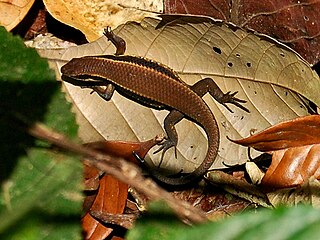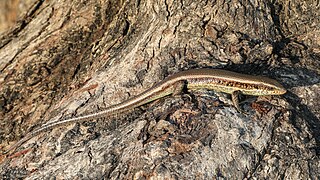
Eutropius was a Roman official and historian. His book Breviarium Historiae Romanae summarizes events from the founding of Rome in the 8th century BC down to the author's lifetime. Appreciated by later generations for its clear presentation and writing style, the Breviarium can be used as a supplement to more comprehensive Roman historical texts that have survived in fragmentary condition.
Eutropis ashwamedhi, also known commonly as the Ashwamedh supple skink or Ashwamedha writhing skink, is a species of lizard in the family Scincidae. The species is endemic to India.
Eutropis allapallensis, the Allapalli grass skink or Schmidt's mabuya, is a species of skink endemic to India.

Eutropis carinata, commonly known as the keeled Indian mabuya, many-keeled grass skink or (ambiguously) "golden skink", is a species of skink found in South Asia.

Eutropis clivicola, known as Inger's mabuya or mountain skink, is a species of skink found in India (Kerala). It was first formally described in 1984 as Mabuya clivicola.
Eutropis dawsoni, also known commonly as Gans's grass skink and Gans's mabuya, is a species of lizard in the family Scincidae. The species is endemic to the southern Western Ghats, India.

The bronze grass skink, bronze mabuya or speckled forest skink, is a species of skink found in South and Southeast Asia. It is a common, but shy, ground-dwelling species that is active both day and night.

Eutropis multifasciata, commonly known as the East Indian brown mabuya, many-lined sun skink, many-striped skink, common sun skink or (ambiguously) as golden skink, is a species of skink that inhabits an extensive range from India and southern China to southern Indonesia.

Beautiful mabuya of four-lined mabuya is a species of skink. It was previously assigned to the genus Mabuya, but following splitting up of this genus, the beautiful mabuya was assigned to the genus Eutropis. Distribution: India, Myanmar Type locality: Bhamo and hills to the east

Eutropis rudis, commonly known as the rough mabuya or brown mabuya, is a species of skink. It is found in the Maritime Southeast Asia: Indonesia, Malaysia, Philippine Islands, Sulu Islands, as well as on the Nicobar islands of India.

Eutropis rugifera, variously known as Nicobar Island skink or rough-scaled sun skink, is a species of skink from southeastern Asia.

Eutropis is a genus of skinks belonging to the subfamily Mabuyinae. For long, this genus was included in the "wastebin taxon" Mabuya; it contains the Asian mabuyas. They often share their habitat with the related common skinks (Sphenomorphus), but they do not compete significantly as their ecological niches differ. This genus also contains the only member of the subfamily to occur in Australasia, the many-lined sun skink, whose wide range includes New Guinea.
Eutropis madaraszi, also known commonly as the Sri Lanka bronze mabuya, the Sri Lanka bronze skink, or (ambiguously) the spotted skink, is a species of lizard in the family Scincidae. The species is endemic to the island of Sri Lanka.
Eutropis tammanna is a species of skink endemic to the island of Sri Lanka.
The upland sun skink is a species of skink found in the Philippines.
Lapu-lapu's sun skink is a species of skink found in the Philippines.
Eutropis resetarii is a species of skink, a lizard in the family Scincidae. The species is endemic to Sri Lanka.
Eutropis alcalai is a species of skink, a lizard in the family Scincidae. The species is endemic to the Philippines.








